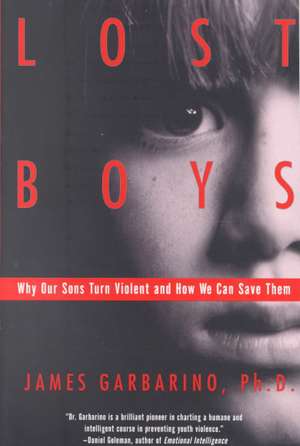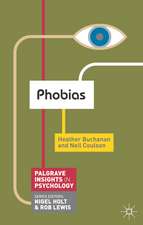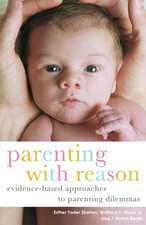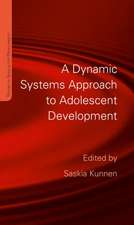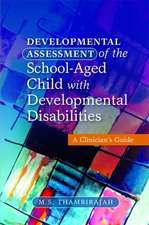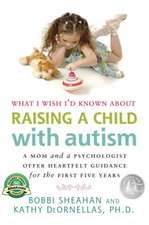Lost Boys: Why Our Sons Turn Violent and How We Can Save Them
Autor James Garbarinoen Limba Engleză Paperback – 31 iul 2000
In the past few years our national consciousness has been altered by haunting images of mass slaughters in American high schools, carried out by troubled young boys with guns. It's now clear that no matter where we live or how hard we try as parents, our children are likely to be going to school with boys who are capable of getting guns and pulling triggers. What has caused teen violence to spread from the urban war-zones of large cities right into the country's heartland? And what can we do to stop this terrifying trend?
James Garbarino, Ph.D., Cornell University professor and nationally noted psychologist, insists that there are things that we, both as individuals and as a society, can do. In a richly anecdotal style he outlines warning signs that parents and teachers can recognize, and suggests steps that can be taken to turn angry and unhappy boys away from violent action. Full of insight, vivid individual portraits, practical advice and considered hope, this is one of the most important and original books ever written about boys.
Preț: 116.57 lei
Nou
Puncte Express: 175
Preț estimativ în valută:
22.31€ • 24.22$ • 18.74£
22.31€ • 24.22$ • 18.74£
Carte tipărită la comandă
Livrare economică 22 aprilie-06 mai
Preluare comenzi: 021 569.72.76
Specificații
ISBN-13: 9780385499323
ISBN-10: 0385499329
Pagini: 288
Dimensiuni: 132 x 201 x 18 mm
Greutate: 0.23 kg
Ediția:Anchor Books.
Editura: Anchor Books
ISBN-10: 0385499329
Pagini: 288
Dimensiuni: 132 x 201 x 18 mm
Greutate: 0.23 kg
Ediția:Anchor Books.
Editura: Anchor Books
Notă biografică
James Garbarino, Ph.D., is Co-Director of the Family Life Development Center and Professor of Human Development at Cornell University in Ithaca, New York.
Extras
I
THE EPIDEMIC OF YOUTH VIOLENCE
PROLOGUE: CHICAGO, JANUARY 1994
I lived and worked in Chicago for almost ten years, from the mid-1980s to the mid-1990s. My children grew up there. Throughout 1993, the Chicago Tribune published in-depth profiles of every kid who was killed in Chicago that year. As an expert on violence and trauma, I spent a lot of time talking with reporters in an attempt to help them make sense of what they had found during their investigation of each case. The reporters worked on the project all through 1993, and in a single issue at the beginning of 1994 the Tribune published the photo and name of every single child and teenager who had been murdered during the previous twelve months. It was a chilling and haunting sight to see the rows and rows of names and faces-sixty-one in all.
The same night the Tribune published the death toll from 1993, my seventeen-year-old son Josh was heading out for an evening on the town with his friends. "Be careful," I said. "It's dangerous out there, and I worry about you." He turned to me, with the Tribune in hand, and said, "Don't worry, Dad. Just how many white faces and names like mine do you see in the newspaper?" The reality was that in 1994 he could reassure me by this simple reference to the facts of the matter; you had to look long and hard at those rows of photos in the Tribune to find a white teenage face with a non-Hispanic surname. Even though we lived in the city, within walking distance of some of the most violent streets in America, Josh felt safe.
When my son's observation forced me to confront this reality, I recalled a meeting I had attended just weeks before. I was the lone white person on a panel of African American and Hispanic professionals for a community forum on violence. During the coffee break we panel members began chatting among ourselves, and it turned out that all of us had teenage sons. As we talked about being parents of teenagers in the city, it became clear to me that while I worried when my son went out at night, my African American and Hispanic colleagues felt dread, because they thought of their boys as part of an endangered species, even though the actual number of children killed that year was less than one hundred in a city of three million. But that number is a compelling feature of the violence problem; even a relatively small number of deaths can stimulate a profound sense of threat and insecurity in a community. Homicide is the leading cause of death for minority male youth, and each new death creates tremendous psychological reverberations. The feeling of extreme apprehension my colleagues experienced was neither paranoid nor far-fetched.
That was 1994. Fast-forward to 1998. By May of that year, I was living and working in Ithaca, a small university town located in the rolling hills of central New York State. Ithaca is a lovely place, mostly known for being the home of Cornell University. For many years and for most of its citizens, Ithaca has been a kind of idyllic paradise where the big news is likely to be the awarding of a prize to a member of Cornell's faculty or a local school board meeting (among vegetarians it is famous as the home of the Moosewood Restaurant, which inspired a popular cookbook).
On May 22, 1998, my fifteen-year-old daughter Joanna and my fourteen-year-old stepson Eric sat at the kitchen table reading the newspaper, which that morning was filled with accounts of the shooting of twenty-four students in Springfield, Oregon, by fifteen-year-old Kip Kinkel. Looking up from the front-page story, Joanna, shaking her head, said, "I wonder who it's going to be at our school."
NO ONE IS IMMUNE
The 1997-1998 school year will go down in American history as the turning point in our country's experience and understanding of lethal youth violence. October 1, 1997, Pearl, Mississippi: after killing his mother, sixteen-year-old Luke Woodham opens fire at his high school, killing three and wounding seven. December 1, 1997, West Paducah, Kentucky: fourteen-year-old Michael Carneal kills three students at a high school prayer meeting. March 24, 1998, Jonesboro, Arkansas: thirteen-year-old Mitchell Johnson and eleven-year-old Andrew Golden open fire on their schoolmates, killing four of them and a teacher. April 24, 1998, Edinboro, Pennsylvania: fourteen-year-old Andrew Wurst kills a teacher at a school dance. May 21, 1998, Springfield, Oregon: after killing his parents, fifteen-year-old Kip Kinkel walks into the school cafeteria and shoots twenty-four classmates, two fatally.
These cases made the national and international news. All the assailants were middle-class, white teenagers from small towns or the suburbs. But these headline-grabbing shooting sprees reminded some families and victims of youth violence of crimes that, although similar, did not seem to merit the attention of the national and international media. Standing just offscreen, beyond our gaze, were hundreds of other kids who had committed acts of lethal violence. Most of us never heard about the adolescents who shot and killed other kids in the inner-city neighborhoods of Houston, Chicago, New York, Los Angeles, and Detroit during that same school year. They remained mostly anonymous.
What about the fourteen-year-old African American kid who shot an eighteen-year-old convenience store clerk? The fifteen-year-old Hispanic kid who opened fire with an assault rifle on a street full of kids? 'The sixteen-year-old African American who gunned down three teens outside his apartment building? The fifteen-year-old Asian boy who executed a sixteen-year-old with a single shot to the head? Rarely do cases like these make the national news, and when they do, the perpetrators are usually described in dehumanized terms ("cold-blooded," "remorseless," "vicious") that lead us to speculate on whether or not these kids are even human. Rarely do we hear of inquiries into their emotional lives or of efforts to make sense of their acts. Why is that?
Is it because the high-visibility cases all involved white kids from the small towns and suburbs of the American heartland while the anonymous killers were poor kids, predominantly African American and Hispanic, living in inner-city neighborhoods? Is it easier for the media and the general public to forget or demonize the low-income minority kids who kill? Some informed observers of the role of race and class in our society have said publicly that they think the answer is yes.
Given our society's history of institutional and interpersonal racism, it would be naive to think that poor minority kids automatically get the same attention and concern as white and middle-class kids do. A number of respected African American psychiatrists, psychologists, lawyers, and community leaders addressed this point in interviews conducted by journalist Zachary Dowdy in 1998. Harvard psychiatrist Alvin Poussaint said, "When white middle-class kids kill, there is always a public outcry of why and a search for what went wrong, but when inner-city minority kids kill, the public is warned of demons and superpredators." Bill Talley, a public defender who has spent years representing inner-city kids in court, put it this way, "No one's calling these white youths 'maggots or animals.'" Judge Milton Wright noted that when Kip Kinkel committed his murders in Springfield, Oregon, Newsweek began its coverage this way: "With his shy smile and slight build, 15-year-old Kip Kinkel has an innocent look that is part Huck Finn and part Alfred E. Neuman-boyish and quintessentially American." Wright went on to say, "Quintessentially American? That always means white."
I have seen firsthand verification of this class and race bias. When I began working on issues of lethal violence and violent trauma in the lives of inner-city kids more than a decade ago, it was hard to get the attention of most Americans, beyond the professionals and parents who lived or worked in inner-city minority communities. The rest of America could afford to ignore the violence when it seemed to be "them," not "us." Perhaps the worst example of this came when a staff member from a congressional committee visited me in my office in Chicago to discuss the issue of lethal youth violence. He found out the problem was mainly confined to inner-city minority populations, and when he communicated this fact to the legislators he represented, they decided it wasn't worth holding hearings on the matter. Nasty, indeed, but brutally honest as an expression of politics as usual.
But the lack of interest among mainstream white America has its origins in more than racism and class bias. Until recently, most American parents could count on the fact that random youth violence was not their problem but a problem for others. After all, 84 percent of the counties in the entire country recorded no youth homicides at all in 1995, and parents and children in most places must have felt a kind of immunity-if they thought about it at all-because they, like my son in 1994, didn't see themselves in the pictures of the killers and the killed. But that was before Jonesboro and Paducah and Springfield, before the cast of characters expanded, and young middle-class Americans, like my daughter, came to see that this could happen to them and their schoolmates.
Now new voices of concern are heard, new faces appear in the newspaper, and new people show up for my lectures and my workshops on violence, trauma, and kids who kill. The killings in the small towns and suburbs during the 1997-1998 school year have served as a kind of wake-up call for America. But this is also an opportunity for Americans to wake up to the fact that the terrible phenomenon of youth violence has been commonplace for the past twenty years and to learn from the experiences of those who have lived with this problem for the last two decades.
In June of 1998, I was speaking at a meeting of mothers who had buried murdered sons. There were more than a dozen mothers in the audience, mostly African American and Hispanic women, bearing the black-draped photos of their dead sons and wearing the commemorative ribbons as testimony to an epidemic of lethal youth violence that is all too familiar to them. But they are no longer alone. The old faces and voices have not disappeared or grown silent but, rather, have been added to as every parent in the country now wonders, Where next? Is my child safe? Could it happen here? What can we do?
WHAT CAN WE LEARN FROM THE PAST?
What do the large number of anonymous killings have to do with the highly publicized killings in Jonesboro and Paducah and Springfield? What do they have in common? In this book we will find answers by moving beyond the surface differences between the two groups of violent boys-principally class and race-to see the profound emotional and psychological similarities that link them together. By getting to know the circumstances under which the epidemic of youth violence first took hold, among low-income minority youth in inner-city areas, we can begin to gain some insight into the lives of the boys in places like Jonesboro, Paducah, and Springfield.
My goal is to understand why kids kill and to help other parents and professionals understand so that they can do something to prevent it in the future. Certainly, there are individuals and cases that defy explanation; some youth violence is committed by kids who have totally lost touch with reality. But these truly are the exceptions. I believe we can make some sense of youth violence from the inside out, that is, by looking deeply into the lives of kids who kill and by listening closely to their own stories. In doing so we can see how problems accumulate and recognize the sequence of events in the life of a child that leads from childhood play to lethal violence, whether these events occur in urban war zones or in the small towns and suburbs of the heartland.
For the past twenty-five years I have studied children and youth in many different settings. My research fills books. Hardly a week goes by that I don't talk with a journalist or get on an airplane to go lecture to professionals or concerned citizens about murder, child abuse, war, and other violent trauma. How do I know what to say to people? Where do I find clues to understand how an innocent infant grows up to be a killer? In my work I always try to combine two sources of information: First, I listen to children who have killed to hear their individual stories. Second, I examine systematic research on the causes of violence in the lives of children and youth. In the pages and chapters that follow, I blend these two sources, drawing upon one to illuminate and make sense of the other, always with the intent to show how what we have learned about the epidemic of killing among inner-city boys can shed light on the boys of the American heartland who are the new casualties of that epidemic.
HOW MUCH KILLING IS THERE?
The FBI reports that there are about twenty-three thousand homicides each year in the United States. In about 10 percent of these cases, the perpetrator is under eighteen years of age. If we extend the age cutoff to include youth up to the age of twenty-one, the figure is about 25 percent. But while the homicide data, which are used widely for comparative purposes, may be reliable, their meanings are not transparent or unambiguous. There are many complexities and subtleties to be considered in making sense of the numbers.
For one thing, improved medical trauma technology has meant that an injury that would have been fatal just twenty years ago is today much less likely to result in death. Children survive gunshot wounds and stabbings that once were fatal, just as a 90 percent cure rate saves them from certain childhood cancers that forty years ago promised a nearly certain early death. An example of the change with respect to homicide is seen in Chicago, where from the mid-1970s to the mid-1990s the number of serious assaults (attacks that could lead to the death of the victim) increased 400 percent while the homicide rate remained about the same. This factor is particularly important when we try to took at long-term historical trends, such as when we compare the homicide rate of the nineteenth century with that of the twentieth century or when we compare data from the first half of this century with data from the last ten or twenty years.
Furthermore, any consideration of the overall homicide rate should be tempered by an appreciation of the role of age and gender in this crime. For instance, it is well known that young men are about ten times as likely as young women to commit murder. Thus, historical comparisons may be skewed by changes in the population's age and gender profile. For example, if a society with an average age of fifteen has the same total homicide rate as a society with an average age of thirty, it probably means that the first society has much less lethal youth violence than the second one.
THE EPIDEMIC OF YOUTH VIOLENCE
PROLOGUE: CHICAGO, JANUARY 1994
I lived and worked in Chicago for almost ten years, from the mid-1980s to the mid-1990s. My children grew up there. Throughout 1993, the Chicago Tribune published in-depth profiles of every kid who was killed in Chicago that year. As an expert on violence and trauma, I spent a lot of time talking with reporters in an attempt to help them make sense of what they had found during their investigation of each case. The reporters worked on the project all through 1993, and in a single issue at the beginning of 1994 the Tribune published the photo and name of every single child and teenager who had been murdered during the previous twelve months. It was a chilling and haunting sight to see the rows and rows of names and faces-sixty-one in all.
The same night the Tribune published the death toll from 1993, my seventeen-year-old son Josh was heading out for an evening on the town with his friends. "Be careful," I said. "It's dangerous out there, and I worry about you." He turned to me, with the Tribune in hand, and said, "Don't worry, Dad. Just how many white faces and names like mine do you see in the newspaper?" The reality was that in 1994 he could reassure me by this simple reference to the facts of the matter; you had to look long and hard at those rows of photos in the Tribune to find a white teenage face with a non-Hispanic surname. Even though we lived in the city, within walking distance of some of the most violent streets in America, Josh felt safe.
When my son's observation forced me to confront this reality, I recalled a meeting I had attended just weeks before. I was the lone white person on a panel of African American and Hispanic professionals for a community forum on violence. During the coffee break we panel members began chatting among ourselves, and it turned out that all of us had teenage sons. As we talked about being parents of teenagers in the city, it became clear to me that while I worried when my son went out at night, my African American and Hispanic colleagues felt dread, because they thought of their boys as part of an endangered species, even though the actual number of children killed that year was less than one hundred in a city of three million. But that number is a compelling feature of the violence problem; even a relatively small number of deaths can stimulate a profound sense of threat and insecurity in a community. Homicide is the leading cause of death for minority male youth, and each new death creates tremendous psychological reverberations. The feeling of extreme apprehension my colleagues experienced was neither paranoid nor far-fetched.
That was 1994. Fast-forward to 1998. By May of that year, I was living and working in Ithaca, a small university town located in the rolling hills of central New York State. Ithaca is a lovely place, mostly known for being the home of Cornell University. For many years and for most of its citizens, Ithaca has been a kind of idyllic paradise where the big news is likely to be the awarding of a prize to a member of Cornell's faculty or a local school board meeting (among vegetarians it is famous as the home of the Moosewood Restaurant, which inspired a popular cookbook).
On May 22, 1998, my fifteen-year-old daughter Joanna and my fourteen-year-old stepson Eric sat at the kitchen table reading the newspaper, which that morning was filled with accounts of the shooting of twenty-four students in Springfield, Oregon, by fifteen-year-old Kip Kinkel. Looking up from the front-page story, Joanna, shaking her head, said, "I wonder who it's going to be at our school."
NO ONE IS IMMUNE
The 1997-1998 school year will go down in American history as the turning point in our country's experience and understanding of lethal youth violence. October 1, 1997, Pearl, Mississippi: after killing his mother, sixteen-year-old Luke Woodham opens fire at his high school, killing three and wounding seven. December 1, 1997, West Paducah, Kentucky: fourteen-year-old Michael Carneal kills three students at a high school prayer meeting. March 24, 1998, Jonesboro, Arkansas: thirteen-year-old Mitchell Johnson and eleven-year-old Andrew Golden open fire on their schoolmates, killing four of them and a teacher. April 24, 1998, Edinboro, Pennsylvania: fourteen-year-old Andrew Wurst kills a teacher at a school dance. May 21, 1998, Springfield, Oregon: after killing his parents, fifteen-year-old Kip Kinkel walks into the school cafeteria and shoots twenty-four classmates, two fatally.
These cases made the national and international news. All the assailants were middle-class, white teenagers from small towns or the suburbs. But these headline-grabbing shooting sprees reminded some families and victims of youth violence of crimes that, although similar, did not seem to merit the attention of the national and international media. Standing just offscreen, beyond our gaze, were hundreds of other kids who had committed acts of lethal violence. Most of us never heard about the adolescents who shot and killed other kids in the inner-city neighborhoods of Houston, Chicago, New York, Los Angeles, and Detroit during that same school year. They remained mostly anonymous.
What about the fourteen-year-old African American kid who shot an eighteen-year-old convenience store clerk? The fifteen-year-old Hispanic kid who opened fire with an assault rifle on a street full of kids? 'The sixteen-year-old African American who gunned down three teens outside his apartment building? The fifteen-year-old Asian boy who executed a sixteen-year-old with a single shot to the head? Rarely do cases like these make the national news, and when they do, the perpetrators are usually described in dehumanized terms ("cold-blooded," "remorseless," "vicious") that lead us to speculate on whether or not these kids are even human. Rarely do we hear of inquiries into their emotional lives or of efforts to make sense of their acts. Why is that?
Is it because the high-visibility cases all involved white kids from the small towns and suburbs of the American heartland while the anonymous killers were poor kids, predominantly African American and Hispanic, living in inner-city neighborhoods? Is it easier for the media and the general public to forget or demonize the low-income minority kids who kill? Some informed observers of the role of race and class in our society have said publicly that they think the answer is yes.
Given our society's history of institutional and interpersonal racism, it would be naive to think that poor minority kids automatically get the same attention and concern as white and middle-class kids do. A number of respected African American psychiatrists, psychologists, lawyers, and community leaders addressed this point in interviews conducted by journalist Zachary Dowdy in 1998. Harvard psychiatrist Alvin Poussaint said, "When white middle-class kids kill, there is always a public outcry of why and a search for what went wrong, but when inner-city minority kids kill, the public is warned of demons and superpredators." Bill Talley, a public defender who has spent years representing inner-city kids in court, put it this way, "No one's calling these white youths 'maggots or animals.'" Judge Milton Wright noted that when Kip Kinkel committed his murders in Springfield, Oregon, Newsweek began its coverage this way: "With his shy smile and slight build, 15-year-old Kip Kinkel has an innocent look that is part Huck Finn and part Alfred E. Neuman-boyish and quintessentially American." Wright went on to say, "Quintessentially American? That always means white."
I have seen firsthand verification of this class and race bias. When I began working on issues of lethal violence and violent trauma in the lives of inner-city kids more than a decade ago, it was hard to get the attention of most Americans, beyond the professionals and parents who lived or worked in inner-city minority communities. The rest of America could afford to ignore the violence when it seemed to be "them," not "us." Perhaps the worst example of this came when a staff member from a congressional committee visited me in my office in Chicago to discuss the issue of lethal youth violence. He found out the problem was mainly confined to inner-city minority populations, and when he communicated this fact to the legislators he represented, they decided it wasn't worth holding hearings on the matter. Nasty, indeed, but brutally honest as an expression of politics as usual.
But the lack of interest among mainstream white America has its origins in more than racism and class bias. Until recently, most American parents could count on the fact that random youth violence was not their problem but a problem for others. After all, 84 percent of the counties in the entire country recorded no youth homicides at all in 1995, and parents and children in most places must have felt a kind of immunity-if they thought about it at all-because they, like my son in 1994, didn't see themselves in the pictures of the killers and the killed. But that was before Jonesboro and Paducah and Springfield, before the cast of characters expanded, and young middle-class Americans, like my daughter, came to see that this could happen to them and their schoolmates.
Now new voices of concern are heard, new faces appear in the newspaper, and new people show up for my lectures and my workshops on violence, trauma, and kids who kill. The killings in the small towns and suburbs during the 1997-1998 school year have served as a kind of wake-up call for America. But this is also an opportunity for Americans to wake up to the fact that the terrible phenomenon of youth violence has been commonplace for the past twenty years and to learn from the experiences of those who have lived with this problem for the last two decades.
In June of 1998, I was speaking at a meeting of mothers who had buried murdered sons. There were more than a dozen mothers in the audience, mostly African American and Hispanic women, bearing the black-draped photos of their dead sons and wearing the commemorative ribbons as testimony to an epidemic of lethal youth violence that is all too familiar to them. But they are no longer alone. The old faces and voices have not disappeared or grown silent but, rather, have been added to as every parent in the country now wonders, Where next? Is my child safe? Could it happen here? What can we do?
WHAT CAN WE LEARN FROM THE PAST?
What do the large number of anonymous killings have to do with the highly publicized killings in Jonesboro and Paducah and Springfield? What do they have in common? In this book we will find answers by moving beyond the surface differences between the two groups of violent boys-principally class and race-to see the profound emotional and psychological similarities that link them together. By getting to know the circumstances under which the epidemic of youth violence first took hold, among low-income minority youth in inner-city areas, we can begin to gain some insight into the lives of the boys in places like Jonesboro, Paducah, and Springfield.
My goal is to understand why kids kill and to help other parents and professionals understand so that they can do something to prevent it in the future. Certainly, there are individuals and cases that defy explanation; some youth violence is committed by kids who have totally lost touch with reality. But these truly are the exceptions. I believe we can make some sense of youth violence from the inside out, that is, by looking deeply into the lives of kids who kill and by listening closely to their own stories. In doing so we can see how problems accumulate and recognize the sequence of events in the life of a child that leads from childhood play to lethal violence, whether these events occur in urban war zones or in the small towns and suburbs of the heartland.
For the past twenty-five years I have studied children and youth in many different settings. My research fills books. Hardly a week goes by that I don't talk with a journalist or get on an airplane to go lecture to professionals or concerned citizens about murder, child abuse, war, and other violent trauma. How do I know what to say to people? Where do I find clues to understand how an innocent infant grows up to be a killer? In my work I always try to combine two sources of information: First, I listen to children who have killed to hear their individual stories. Second, I examine systematic research on the causes of violence in the lives of children and youth. In the pages and chapters that follow, I blend these two sources, drawing upon one to illuminate and make sense of the other, always with the intent to show how what we have learned about the epidemic of killing among inner-city boys can shed light on the boys of the American heartland who are the new casualties of that epidemic.
HOW MUCH KILLING IS THERE?
The FBI reports that there are about twenty-three thousand homicides each year in the United States. In about 10 percent of these cases, the perpetrator is under eighteen years of age. If we extend the age cutoff to include youth up to the age of twenty-one, the figure is about 25 percent. But while the homicide data, which are used widely for comparative purposes, may be reliable, their meanings are not transparent or unambiguous. There are many complexities and subtleties to be considered in making sense of the numbers.
For one thing, improved medical trauma technology has meant that an injury that would have been fatal just twenty years ago is today much less likely to result in death. Children survive gunshot wounds and stabbings that once were fatal, just as a 90 percent cure rate saves them from certain childhood cancers that forty years ago promised a nearly certain early death. An example of the change with respect to homicide is seen in Chicago, where from the mid-1970s to the mid-1990s the number of serious assaults (attacks that could lead to the death of the victim) increased 400 percent while the homicide rate remained about the same. This factor is particularly important when we try to took at long-term historical trends, such as when we compare the homicide rate of the nineteenth century with that of the twentieth century or when we compare data from the first half of this century with data from the last ten or twenty years.
Furthermore, any consideration of the overall homicide rate should be tempered by an appreciation of the role of age and gender in this crime. For instance, it is well known that young men are about ten times as likely as young women to commit murder. Thus, historical comparisons may be skewed by changes in the population's age and gender profile. For example, if a society with an average age of fifteen has the same total homicide rate as a society with an average age of thirty, it probably means that the first society has much less lethal youth violence than the second one.
Recenzii
"Garbarino not only makes the clearest and most persuasive arguments of the current [books on the subject], but he is also the best storyteller."--Time Out New York
"Parents and social workers and even politicians could do a lot worse than follow his advice--. A therapeutic primer."--The Nation
"Dr. Garbarino is a brilliant pioneer in charting a humane and intelligent course in preventing youth violence."--Daniel Goleman, author of Emotional Intelligence
"Jim Garbarino sounds the alarm about the spread of youth violence--. Focusing on the hurt and social alienation that are at the heart of youth violence, he offers not only insight and compassion, but also steps that will lead to prevention and intervention."--Marian Wright Edelman, President, The Children's Defense Fund
"Garbarino's work is a guiding light for national policies, as well as individual parents and other citizens."--Stanley I. Greenspan, M.D., author of Playground Politics: Understanding The Emotional Life of the School-Age Child
"I can think of few more qualified and eloquent than Jim Garbarino to address these questions [of teen violence]. His is a voice of reason and one grounded in reality. It is a voice, a moral voice, we should feel fortunate to have among us."--Alex Kotlowitz, author of There Are No Children Here
"Parents and social workers and even politicians could do a lot worse than follow his advice--. A therapeutic primer."--The Nation
"Dr. Garbarino is a brilliant pioneer in charting a humane and intelligent course in preventing youth violence."--Daniel Goleman, author of Emotional Intelligence
"Jim Garbarino sounds the alarm about the spread of youth violence--. Focusing on the hurt and social alienation that are at the heart of youth violence, he offers not only insight and compassion, but also steps that will lead to prevention and intervention."--Marian Wright Edelman, President, The Children's Defense Fund
"Garbarino's work is a guiding light for national policies, as well as individual parents and other citizens."--Stanley I. Greenspan, M.D., author of Playground Politics: Understanding The Emotional Life of the School-Age Child
"I can think of few more qualified and eloquent than Jim Garbarino to address these questions [of teen violence]. His is a voice of reason and one grounded in reality. It is a voice, a moral voice, we should feel fortunate to have among us."--Alex Kotlowitz, author of There Are No Children Here
Descriere
A leading psychologist examines the recent explosion of adolescent violence, identifies children at risk, and offers proven methods to prevent aggressive behavior.
